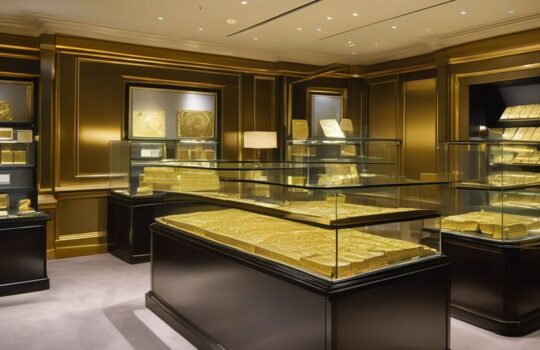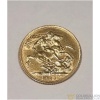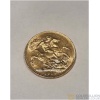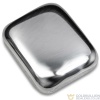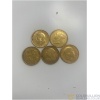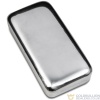Exploring the Price of 1 oz Gold Bar

Gold has been a valuable and sought-after metal throughout history. It has been used in ancient civilizations, played a significant role in the Middle Ages, and continues to be highly valued in modern times. In this article, we will explore the price of a 1 oz gold bar and the factors that influence it. We will also look at the historical price trends and the current market value of gold. Here are the key takeaways:
Key Takeaways
- The price of a 1 oz gold bar is influenced by various factors such as supply and demand, economic conditions, and geopolitical events.
- Historically, the price of gold has shown upward trends with occasional fluctuations.
- The current market value of a 1 oz gold bar can be obtained from reputable sources such as financial institutions or precious metal dealers.
- Investing in gold can provide a hedge against inflation and diversify investment portfolios.
- Gold bars are a popular form of investment due to their high purity and liquidity.
The History of Gold

Gold in Ancient Civilizations
Gold has been valued for thousands of years and is considered a hedge against inflation. It offers diversification and stability in investment portfolios, with tax benefits. Factors to consider when buying gold include purity, quality, and market liquidity.
Gold in the Middle Ages
During the Middle Ages, gold continued to hold significant value and played a crucial role in the economic and social systems of the time. It was used as a medium of exchange, a store of wealth, and a symbol of power and prestige. Merchants and nobles accumulated vast amounts of gold, which they used to finance their businesses and fund their lavish lifestyles. Gold was also used to create intricate jewellery and adornments, showcasing the wealth and status of the elite. The demand for gold during this period led to the establishment of trade routes and the development of banking systems to facilitate its exchange. Goldsmiths emerged as skilled craftsmen, specialising in the art of working with gold and creating exquisite pieces of jewellery and decorative objects.
Gold in Modern Times
In modern times, gold has continued to hold its value and serve as a safe haven investment. The price of gold has reached record highs, with expectations of further increases in the future. Factors such as a weakening US dollar and interest rate cuts have contributed to the rise in gold prices. Gold is seen as an insurance policy during times of economic uncertainty, providing stability and preserving wealth. It has outperformed other investments during periods of economic turbulence, making it a popular choice for investors.
The Properties of Gold

Physical Properties of Gold
Gold has several unique physical properties that contribute to its value and desirability. One of the most notable properties of gold is its density, as it is one of the densest metals. Gold is also an excellent conductor of heat and electricity. Additionally, gold is known for its softness and is considered the most malleable and ductile of all the elements. These physical properties make gold highly versatile and useful in various industries.
Chemical Properties of Gold
Gold has several unique chemical properties that contribute to its value and desirability. One of the most notable properties of gold is its resistance to corrosion. Unlike many other metals, gold does not tarnish or rust when exposed to air or moisture. This makes gold an excellent choice for jewellery and other decorative items that need to maintain their appearance over time. Additionally, gold is a very stable element and does not react easily with other substances. This stability allows gold to be used in various industrial applications, such as electronics and medical devices.
Industrial Uses of Gold
Gold has a wide range of industrial uses due to its unique properties. One important use of gold is in the electronics industry, where it is used to make connectors, switches, and other components due to its excellent conductivity and resistance to corrosion. Gold is also used in the medical field for various applications, such as in dental work, surgical instruments, and radiation shielding. Additionally, gold is used in the aerospace industry for its high reflectivity and heat resistance. Overall, the industrial uses of gold make it a valuable and versatile material in various sectors.
The Process of Mining Gold

Exploration and Discovery
During the process of mining gold, exploration and discovery play a crucial role. Exploration involves searching for potential gold deposits through various methods such as geological mapping, geochemical analysis, and geophysical surveys. Once a potential deposit is identified, discovery is made through drilling and sampling to confirm the presence of gold. This phase is essential in determining the viability and potential yield of a gold mine.
To effectively explore and discover gold deposits, mining companies employ advanced technologies and techniques. These include remote sensing, satellite imagery, and airborne surveys to identify areas with high mineral potential. Additionally, geological models and computer simulations are used to predict the location and size of gold deposits.
It is important to note that the exploration and discovery phase can be time-consuming and costly. Mining companies invest significant resources in this stage to ensure the success of their operations. Through careful exploration and discovery, valuable gold deposits can be identified and extracted, contributing to the global supply of this precious metal.
Extraction Methods
The process of extracting gold from the earth involves several methods. One common method is the use of cyanide leaching, where a weak cyanide solution is applied to the ore to dissolve the gold. Another method is gravity separation, which uses the difference in density between gold and other minerals to separate them. Additionally, gold can also be extracted through the use of flotation, where chemicals are added to the ore to make the gold particles attach to air bubbles and rise to the surface. These methods are crucial in obtaining gold from the ore and preparing it for further processing.
Environmental Impact of Gold Mining
Gold mining has significant environmental impacts that need to be considered. One of the major concerns is the release of greenhouse gas (GHG) emissions. According to the World Gold Council, global emissions from the gold mining industry exceed 100 million tonnes of CO2-eq annually. This contributes to climate change and its associated effects. Additionally, gold mining can result in habitat destruction and water pollution. The extraction process often involves the use of toxic chemicals such as cyanide, which can contaminate nearby water sources and harm aquatic life. It is important for mining companies to implement sustainable practises and minimise their environmental footprint.
The Market for Gold

Factors Affecting the Price of Gold
The price of gold is influenced by factors such as supply and demand, investor sentiment, and economic conditions. Market analysis and forecast help investors make informed decisions. Timing the market is challenging, and it’s important to consider ethical and sustainable practises when buying gold.
Gold as an Investment
Investing in gold can be a valuable addition to your investment portfolio. Gold has a low correlation with traditional assets such as stocks and bonds, making it an effective diversification strategy. When stocks are down, gold tends to perform well, providing a hedge against market volatility. Additionally, gold is a tangible asset that can be easily converted into cash when needed. It can be bought or sold to jewellery dealers, pawn shops, coin shops, and traded globally. This high liquidity makes gold a flexible investment option.
Gold as a Commodity
Gold is not only a precious metal but also a widely traded commodity. It is used in various industries, including jewellery, electronics, and dentistry. The demand for gold as a commodity is influenced by factors such as economic conditions, geopolitical events, and investor sentiment. Here are some key points about gold as a commodity:
- Gold is traded on commodity exchanges around the world, with prices quoted in US dollars per ounce.
- The price of gold as a commodity is determined by supply and demand dynamics, as well as market speculation.
- Investors can gain exposure to gold as a commodity through various financial instruments, such as futures contracts and exchange-traded funds (ETFs).
Gold as a commodity provides investors with an opportunity to diversify their portfolios and potentially benefit from price fluctuations. However, it is important to carefully consider the risks and conduct thorough research before investing in gold as a commodity.
The Price of 1 oz Gold Bar

Factors Influencing the Price
The price of 1 oz gold bars in the UK is influenced by factors such as supply and demand, economic conditions, inflation, and market speculation. It is important for investors to monitor these factors and compare premiums when purchasing gold bars.
Historical Price Trends
Historical trends in the price of gold provide valuable insights for investors. Over the past twenty years, the price of gold has shown significant fluctuations. From 1985 to 2005, the price remained relatively steady, ranging between $300 and $500 per ounce. However, starting in 2005, the price began to rise steadily, reaching all-time highs in July 2020 in the US Dollar, Sterling, and Euro. Since then, the price has continued to rally, surpassing $1,500 in early 2016 and reaching around $2,000 at the end of 2023. These trends highlight the potential for gold as a long-term investment.
Current Market Value
The current market value of a 1 oz gold bar is determined by various factors, including the spot price of gold, supply and demand dynamics, and economic conditions. The spot price of gold is the current price at which gold can be bought or sold on the open market. It is influenced by factors such as global economic trends, geopolitical events, and investor sentiment. Supply and demand dynamics also play a role in determining the market value of gold bars. When demand for gold bars exceeds supply, prices tend to rise, and vice versa. Economic conditions, such as inflation and interest rates, can also impact the market value of gold. Investors often turn to gold as a safe haven during times of economic uncertainty, which can drive up prices. It is important for investors to stay informed about these factors to make informed decisions when buying or selling gold bars.
Conclusion
In conclusion, exploring the price of 1 oz gold bars can be a valuable exercise for investors looking to start or diversify their precious metals portfolio. The market offers a variety of options, including gold bars from different mints and with various features. It is important to stay informed about the current prices and compare different products to make an informed decision. Whether you choose a 1 oz gold bar or other forms of gold investment, it is crucial to consider your investment goals and risk tolerance. Investing in gold can provide a hedge against inflation and economic uncertainty, making it a popular choice for many investors.
The Price of 1 oz Gold Bar
What factors influence the price of a 1 oz gold bar?
The price of a 1 oz gold bar is influenced by factors such as supply and demand, economic conditions, geopolitical events, and investor sentiment.
What are the historical price trends of 1 oz gold bars?
Historically, the price of 1 oz gold bars has shown both upward and downward trends. It is important to note that past performance is not indicative of future results.
What is the current market value of a 1 oz gold bar?
The current market value of a 1 oz gold bar can fluctuate based on various factors. It is recommended to check the current market prices from reputable sources.
Are 1 oz gold bars a good investment?
1 oz gold bars can be a good investment option for those looking to diversify their portfolio and hedge against inflation. However, it is important to conduct thorough research and seek professional advice before making any investment decisions.
Can I buy and sell 1 oz gold bars?
Yes, you can buy and sell 1 oz gold bars through various channels such as bullion dealers, banks, and online platforms. It is advisable to compare prices and ensure the authenticity of the bars before making any transactions.
What are the storage options for 1 oz gold bars?
There are several storage options for 1 oz gold bars, including home safes, safety deposit boxes, and secure storage facilities. It is important to choose a storage method that provides adequate security and protection for your investment.


